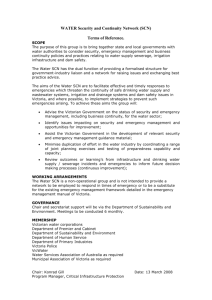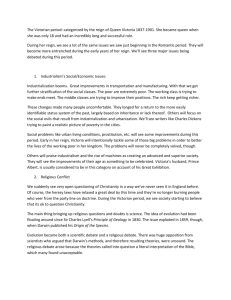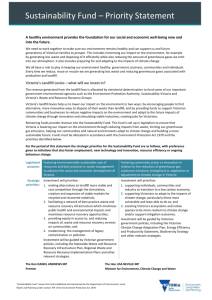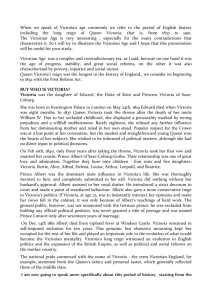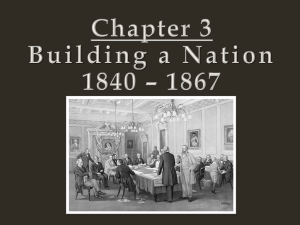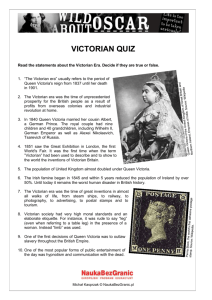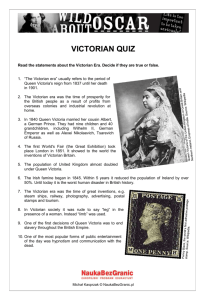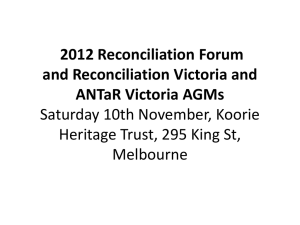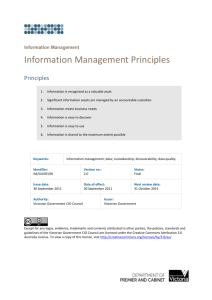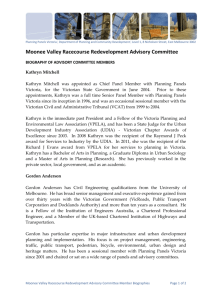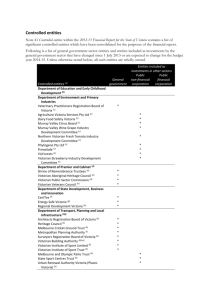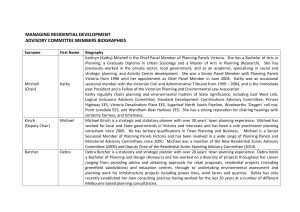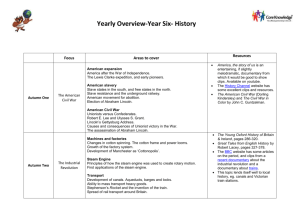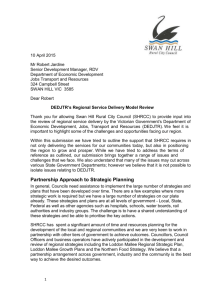Diapositiva 1
advertisement
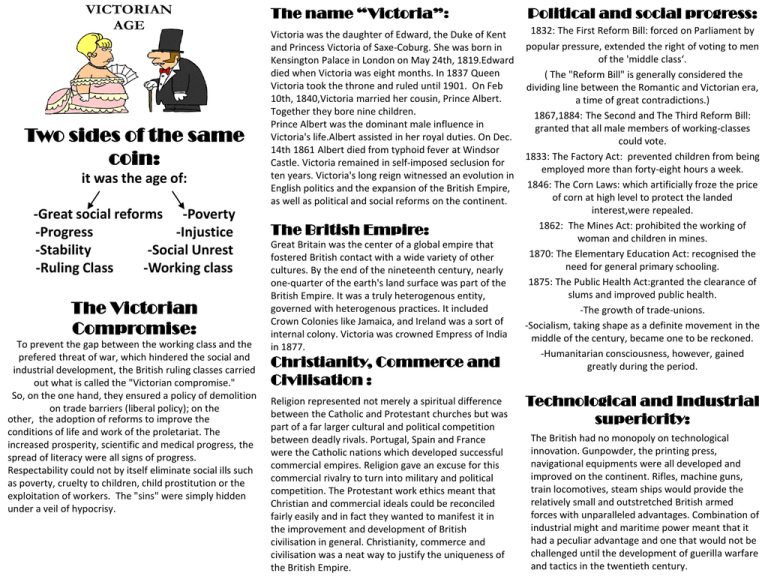
Two sides of the same coin: it was the age of: -Great social reforms -Poverty -Progress -Injustice -Stability -Social Unrest -Ruling Class -Working class The Victorian Compromise: To prevent the gap between the working class and the prefered threat of war, which hindered the social and industrial development, the British ruling classes carried out what is called the "Victorian compromise." So, on the one hand, they ensured a policy of demolition on trade barriers (liberal policy); on the other, the adoption of reforms to improve the conditions of life and work of the proletariat. The increased prosperity, scientific and medical progress, the spread of literacy were all signs of progress. Respectability could not by itself eliminate social ills such as poverty, cruelty to children, child prostitution or the exploitation of workers. The "sins" were simply hidden under a veil of hypocrisy. The name “Victoria”: Political and social progress: Victoria was the daughter of Edward, the Duke of Kent and Princess Victoria of Saxe-Coburg. She was born in Kensington Palace in London on May 24th, 1819.Edward died when Victoria was eight months. In 1837 Queen Victoria took the throne and ruled until 1901. On Feb 10th, 1840,Victoria married her cousin, Prince Albert. Together they bore nine children. Prince Albert was the dominant male influence in Victoria's life.Albert assisted in her royal duties. On Dec. 14th 1861 Albert died from typhoid fever at Windsor Castle. Victoria remained in self-imposed seclusion for ten years. Victoria's long reign witnessed an evolution in English politics and the expansion of the British Empire, as well as political and social reforms on the continent. 1832: The First Reform Bill: forced on Parliament by popular pressure, extended the right of voting to men of the 'middle class‘. ( The "Reform Bill" is generally considered the dividing line between the Romantic and Victorian era, a time of great contradictions.) 1867,1884: The Second and The Third Reform Bill: granted that all male members of working-classes could vote. 1833: The Factory Act: prevented children from being employed more than forty-eight hours a week. 1846: The Corn Laws: which artificially froze the price of corn at high level to protect the landed interest,were repealed. 1862: The Mines Act: prohibited the working of woman and children in mines. 1870: The Elementary Education Act: recognised the need for general primary schooling. 1875: The Public Health Act:granted the clearance of slums and improved public health. -The growth of trade-unions. -Socialism, taking shape as a definite movement in the middle of the century, became one to be reckoned. -Humanitarian consciousness, however, gained greatly during the period. The British Empire: Great Britain was the center of a global empire that fostered British contact with a wide variety of other cultures. By the end of the nineteenth century, nearly one-quarter of the earth's land surface was part of the British Empire. It was a truly heterogenous entity, governed with heterogenous practices. It included Crown Colonies like Jamaica, and Ireland was a sort of internal colony. Victoria was crowned Empress of India in 1877. Christianity, Commerce and Civilisation : Religion represented not merely a spiritual difference between the Catholic and Protestant churches but was part of a far larger cultural and political competition between deadly rivals. Portugal, Spain and France were the Catholic nations which developed successful commercial empires. Religion gave an excuse for this commercial rivalry to turn into military and political competition. The Protestant work ethics meant that Christian and commercial ideals could be reconciled fairly easily and in fact they wanted to manifest it in the improvement and development of British civilisation in general. Christianity, commerce and civilisation was a neat way to justify the uniqueness of the British Empire. Technological and Industrial superiority: The British had no monopoly on technological innovation. Gunpowder, the printing press, navigational equipments were all developed and improved on the continent. Rifles, machine guns, train locomotives, steam ships would provide the relatively small and outstretched British armed forces with unparalleled advantages. Combination of industrial might and maritime power meant that it had a peculiar advantage and one that would not be challenged until the development of guerilla warfare and tactics in the twentieth century. Many destitute children lived by stealing and many people thought that education was the answer. The Victorian age can also be thought of as one of intense philanthropy. Many of our modern day charitable institutions, such as The Children's Society, have their roots at this time. There were private teachers for rich children, orphanages (with strong discipline), for poor children and compulsory education (gender separation). The search for employment also involved the children that were expected to help the family budget. Education and Childcare: The other side of the coin: The nineteenth century saw a huge growth in the population of Great Britain. The growth of the cities was due to the effects of the industrial revolution: people were flocking into the towns in search of employment. Child Labor:They often worked long hours in dangerous jobs and in difficult situations for a very little wage. there were the climbing boys employed by the chimney sweeps, boys and girls working down the coal mines, crawling through tunnels too narrow and low to take an adult. Slums:People needed to live near to where they work but the available housing became scarce and therefore expensive, resulting in extremely overcrowded conditions. Squalor and desease:The roads were crossed by ditch, into which drains and sewers emptied. Poor living conditions led death caused by starvation, destitution and cholera. Victorian Literature: Ideological influences: Puritanism: A religious moviment who want reform the Church of England, according to Calvinism’s principles. Transcendentalism: All reality is a single unity,over same is the spiritual principle, nature is the best means to reach the truth. The most popular genres: Victorian Sexuality: Puritanism and his principles: -hard work -prayer -chastity Rigid division beetween the sexes: Men: active and full of energy; every gentleman is this age had a devoted wife and two prostitutes. Women: had a passive role in relationship and regarded as devoid of sexual desire. The image of woman: In the family the husband represented the authority and the role of woman regarded: -education of children -duties of a wife -Alot of women suffered from hysteria. -Poetry: Emily Dickinson. -managing the house -Novel: romantic novel, adventure, realistic,sensation, historical and novel of manners. Authors and Production: The most important novelist are: Great wealth and extreme poverty lived side by side because the tenements, slums, rookeries were only a stone thrown from the large elegant houses of the rich that didn't care about worker but they created places of entertainment like public houses and music halls. -Charles Dickens: Oliver Twist and David Girl’s education was repressive against natural instincts and woman were not free to live their sexuality publicly. Copperfield. -Bronte sisters;Emily with:Wuthering Hights and Charlotte with: Jane Eyre. -Nathanie Hawthorne: The scarlet letter. -Herman Melville: Moby Dick. -Oscar Wilde: The picture of Dorian Gray. The nude in Victorian Art: Starting from 1830s. The nude became the most debated topic in the art in England. Nudes are presented not only in painting and sculpture but also popular illustation and photografy.




